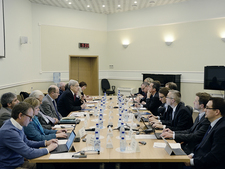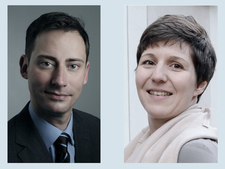-
Topics
subnavigation
Topics
Electromagnetic fields
- What are electromagnetic fields?
- Static and low-frequency fields
- Radiation protection relating to the expansion of the national grid
- High-frequency fields
- Radiation protection in mobile communication
Optical radiation
Ionising radiation
- What is ionising radiation?
- Radioactivity in the environment
- Applications in medicine
- Applications in daily life and in technology
- Effects
- What are the effects of radiation?
- Effects of selected radioactive materials
- Consequences of a radiation accident
- Cancer and leukaemia
- Genetic radiation effects
- Individual radiosensitivity
- Epidemiology of radiation-induced diseases
- Ionising radiation: positive effects?
- Risk estimation and assessment
- Radiation protection
- Nuclear accident management
- Service offers
-
The BfS
subnavigation
The BfS
- About us
- Science and research
- Laws and regulations
- BfS Topics in the Bundestag
- Links
Second Meeting of the Commission of Inquiry on Ruthenium
Cause of ruthenium release remains unclear despite numerous new measurement data
 Second meeting of the Commission of Inquiry on Ruthenium in Moscow, 11. April 2018
Source: IBRAE
Second meeting of the Commission of Inquiry on Ruthenium in Moscow, 11. April 2018
Source: IBRAE
On 11. April 2018 the second meeting of the International Commission of Inquiry on Ruthenium was held in Moscow, and again the Federal Office for Radiation Protection (BfS) was represented by two experts. As before, the meeting was hosted by the Nuclear Safety Institute of the Russian Academy of Sciences (IBRAE).
At this meeting, Russian experts presented numerous measurement data (particularly from soil samples taken in the South Urals) and information collected or compiled since the last meeting in January. BfS, like the other international experts in the Commission, will analyze the data in detail during the next few weeks. Final conclusions can only be drawn after analysis has been completed. According to the BfS's current assessment, it can be expected that further measurements still have to be carried out to provide information on ruthenium release.
In addition, a new database was introduced at the meeting encompassing all available measurement data on the ruthenium release. It is planned to publish this database as a basis for further research and analyses.

![]() Representation of the propagation of ruthenium-106 in the Chelyabinsk region during a potential release at the end of September 2017 (white: no measurement result, blue: very low concentration, green: low concentration)
Representation of the propagation of ruthenium-106 in the Chelyabinsk region during a potential release at the end of September 2017 (white: no measurement result, blue: very low concentration, green: low concentration)
After all new data have been analyzed, the experts in the Commission of Inquiry will make a decision on the next steps to be taken by the Commission of Inquiry.
The full conclusions of the second meeting of the Commission of Inquiry on Ruthenium have been published on the website of the Nuclear Safety Institute of the Russian Academy of Sciences (IBRAE).
Background information
At the end of September 2017, slightly increased radioactivity values in the air were detected at various trace points in Europe. Small quantities of ruthenium-106 were measured at a total of seven stations in Germany and at numerous stations in other European countries (including Austria and Italy). The concentration of the radioactive substance in Germany was very low between a few microbecquerels and a few millibecquerels per cubic meter.

![]() Measuring points at which ruthenium-106 was detected in the air between the end of September and the beginning of October 2017
Measuring points at which ruthenium-106 was detected in the air between the end of September and the beginning of October 2017
BfS calculations on the propagation of radioactive substances in the atmosphere indicated an origin in the southern Urals, and a place of origin in southern Russia could not be ruled out initially. However, data from the Russian meteorological service Roshydromet at the end of November 2017 suggest that areas west and south of the Urals can be excluded due the prevailing wind direction at that time.
Ruthenium-106 is a beta emitter, and its daughter nuclide Rhodium-106 is a very short-lived gamma emitter, so that beta and gamma rays always occur together during the decay of ruthenium-106. Ruthenium-106 has a half-life of slightly more than one year (372 days). Ruthenium-106 is a fission product occurring during the fission of uranium in a nuclear power plant.
Ruthenium-106 is used, among others, as a radiation source for cancer therapy in the treatment of eye tumours. In addition, ruthenium-106 is rarely applied in Radioisotope Thermoelectric Generators (RTG), which are used to power satellites. Ruthenium can also occur in the reprocessing of nuclear fuel assemblies.
State of 2018.02.18



